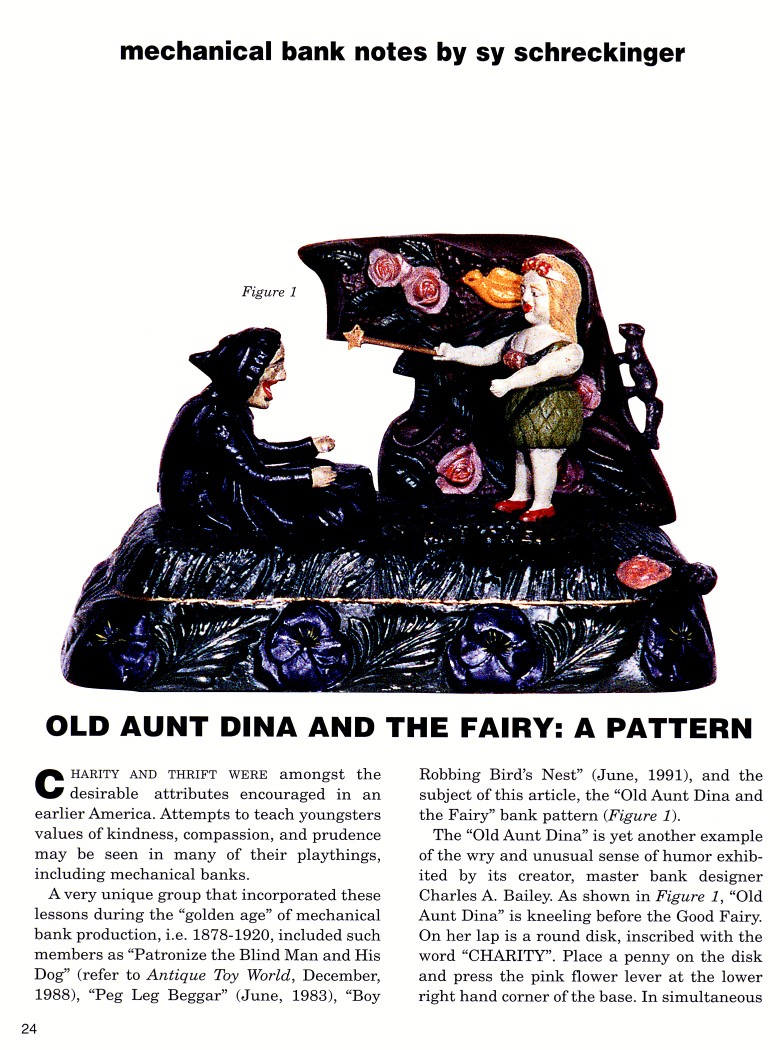|
Old Aunt Dina and the
Fairy: A Pattern
by Sy Schreckinger – ANTIQUE TOY WORLD Magazine – September,
1999
Clarity and thrift were amongst the
desirable attributes encouraged in an earlier America. Attempts to teach
youngsters values of kindness, compassion, and prudence may be seen in
many of their playthings, including mechanical banks.
A very unique group that incorporated these lessons during the
"golden age" of mechanical bank production, i.e. 1878-1920, included such
members as "Patronize the Blind Man and His Dog" (refer to Antique Toy
World, December, 1988), "Peg Leg Beggar" (June, 1983), "Boy Robbing Bird's
Nest" (June, 1991), and the subject of this article, the "Old Aunt Dina
and the Fairy" bank pattern (Figure 1).
The "Old Aunt Dina" is yet another example of the wry and unusual
sense of humor exhibited by its creator, master bank designer Charles A.
Bailey. As shown in Figure 1, "Old Aunt Dina" is kneeling before the Good
Fairy. On her lap is a round disk, inscribed with the word "CHARITY".
Place a penny on the disk and press the pink flower lever at the lower
right hand corner of the base. In simultaneous action, the Good Fairy
lowers her wand, the disk and penny flip over to deposit the coin into the
bank, and "Old Aunt Dina" raises her arms in gratitude as the penny is
magically transformed into a large gold coin imprinted with the words "THE
NEW DOLLAR".
Deposits are removed by undoing a round Stevens-type coin retainer
underneath the base. Interestingly, it is doubtful that this was Mr.
Bailey's intended method of coin removal. At the time the "Aunt Dina" bank
pattern was created Bailey had no association with the J. and E. Stevens
Company, the producer of the patented round coin retainer.
"Old Aunt Dina" is another exemplification of Bailey's unique
mechanical bank storytelling technique. Bold, imprinted words are cast
into its components, as illustrated by the following: the base displays
the words "OLD AUNT DINA AND THE FAIRY; on one side of the disk is the
word "CHARITY", while the flipside reveals "THE NEW DOLLAR". This
narrative style is similar to other mechanicals created and manufactured
solely by Charles Bailey i.e. "Chinaman in the Boat" bank (refer to
Antique Toy World, June, 1999), "Darkey Fisherman Bank" (May, 1999), and
his "Baby Elephant Bank, Opens At X O'Clock" (March, 1999).
The "Old Aunt Dina" bank pattern (Figure 1) was located, in a
disassembled state, at Bailey's defunct foundry in Cobalt, Connecticut,
approximately fifty years ago. Noted historian and collector, Mr. F. H.
Griffith, discovered this, as well as another rare Bailey mechanical bank
pattern, namely "The Wishbone". Mr. Griffith assembled the "Old Aunt Dina"
and sold it to pioneer bank collector, Mr. Covert Hegerty of Williamsport,
Pennsylvania. Mr. Hegerty's wife, Gertrude, decorated the "Aunt Dina"
pattern in colors which she felt would have been chosen by Charles Bailey.
In later years "Old Aunt Dina" was acquired by the prominent bank
collector, Mr. Edwin H. Mosler, who eventually sold it to Mr. Steve
Steckbeck, its present owner.
Of all the banks designed by Bailey at his Cobalt foundry, the "Old
Aunt Dina and the Fairy" most expresses his fondness for, and usage of,
floral motifs and nature forms. Many of these elements were incorporated
into several of his later mechanical masterpieces while in the employ of
the J. and E. Stevens Company of Cromwell, Connecticut. To illustrate: "Darkey
Football Bank" (refer to Antique Toy World,
December, 1998), "Kicking Cow"
(August, 1987), "Bad Accident Bank" (June, 1986), "World's Fair Bank"
(February, 1989), "Perfection Registering Bank" (April, 1986), "Hen and
Chick" (June, 1995), "Lion Hunter Bank" (July, 1985), "Boy Scout Camp"
(March, 1986) and the quintessential Bailey, "Boy Robbing Bird's Nest"
bank (June, 1991).
At the time of its discovery, one brass and several lead copies of
the "Old Aunt Dina" pattern were created, each utilizing the original
example. Although these replications were also assembled and painted,
their crude castings leave little doubt as to their originality. However,
wariness of spurious duplications of this, as well as any rare mechanical
is advised. The authenticity of a rare mechanical bank is best confirmed
by documented provenance and/or validation by an established authority on
the subject. To aid the collector in determining size and scale of the
original "Old Aunt Dina" pattern (Figure 1), I am including a base diagram
as seen in Figure 2.
On a final note: A mechanical bank pattern is not a bank, but rather
a highly detailed, hand-finished model used by a manufacturer or foundry
to generate mass-produced copies for sale to the public.
All past and future articles in this series are the sole property of
Sy and Linda Schreckinger, and may not be republished or reproduced at any
time without their written consent.
|


